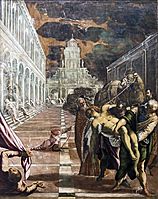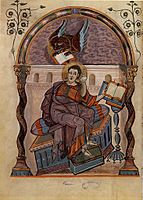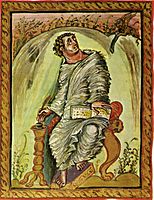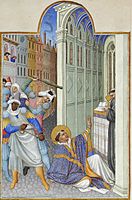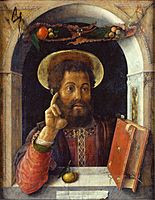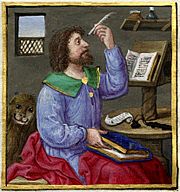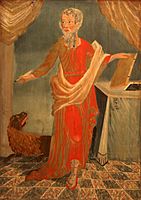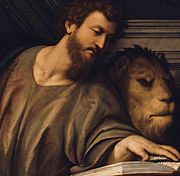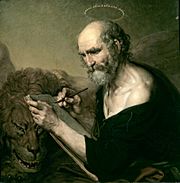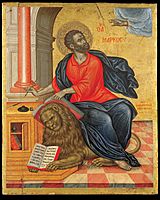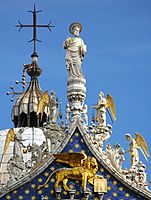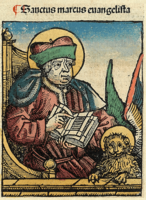Mark the Evangelist facts for kids
Quick facts for kids SaintMark the Evangelist |
|
|---|---|
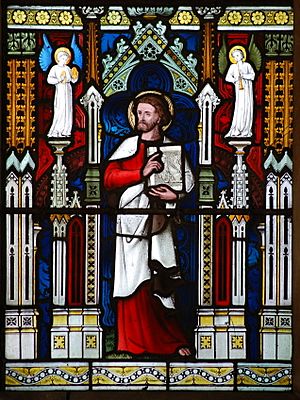
Detail from a window in the parish church of SS Mary and Lambert, Stonham Aspal, Suffolk, with stained glass representing St Mark the Evangelist
|
|
| Evangelist, Martyr | |
| Born | c. 12 AD Cyrene, Pentapolis of North Africa, according to Coptic tradition |
| Died | c. 68 AD (aged c. 56) Alexandria, Egypt, Roman Empire |
| Venerated in | All Christian churches that venerate saints |
| Major shrine | St Mark's Basilica (Venice) Saint Mark's Coptic Orthodox Cathedral (Alexandria) |
| Feast |
|
| Patronage | Barristers, Venice, Egypt, Copts, Mainar |
| Major works | Gospel of Mark (attributed) |
Mark the Evangelist (also known as John Mark) is a very important figure in Christian history. He is traditionally believed to have written the Gospel of Mark, which is one of the four gospels in the Bible.
According to early Church traditions, Mark founded the first major Christian community in Alexandria, Egypt. This city became one of the most important centers for early Christianity. His special day, called a feast day, is celebrated on April 25. Mark's symbol is the winged lion.
Contents
Who was Mark the Evangelist?
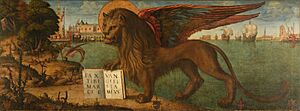
Many people believe that Mark the Evangelist is the same person as John Mark. John Mark is mentioned in the Bible in the book of Acts. He was a cousin of Barnabas, another important early Christian leader.
Some early Christian writers, like Hippolytus of Rome, thought there might have been different people named Mark. However, the most common belief is that Mark the Evangelist and John Mark are the same person.
According to ancient records, Mark traveled with Peter, one of Jesus's main disciples. Mark wrote down Peter's teachings and sermons. This is how the Gospel of Mark is believed to have been created.
After some time, Mark traveled to Alexandria, a big city in Egypt. He started the first Christian church there. This church grew into the Coptic Orthodox Church and other Christian groups in Egypt today. Mark became the first bishop (leader) of the church in Alexandria. He is honored as the person who brought Christianity to Africa.
Later traditions say that Mark was killed in Alexandria in AD 68. This happened because people who followed older religions did not like his efforts to spread Christianity.
Stories and beliefs about Mark
Early Christian writers like Papias of Hierapolis wrote about Mark's role in writing the Gospel. Many scholars today still study these early accounts.
The Coptic Church believes that Mark the Evangelist was one of the 70 disciples sent out by Jesus to share his message. They also believe that the Last Supper and the coming of the Holy Spirit at Pentecost happened in Mark's house. Some traditions even say that Mark was one of the servants at the Marriage at Cana, where Jesus turned water into wine.
Coptic tradition also says that Mark was born in Cyrene, a city in North Africa. It is believed that he returned to this area later in his life. When he came back to Alexandria, he was killed by people who opposed his Christian teachings. They dragged him through the streets until he died.
Honoring Saint Mark
The special day for Saint Mark is April 25. This day is celebrated by the Catholic and Eastern Orthodox Churches. The Coptic Orthodox Church celebrates it on a different date in their calendar, which usually matches May 8 on the modern calendar.
In some traditions, if John Mark is seen as a different person from Mark the Evangelist, John Mark's day is September 27. Mark the Evangelist's day remains April 25.
Mark in art
In art, Mark the Evangelist is often shown writing or holding his gospel. His most famous symbol is the winged lion. This lion is often shown with a book that says "Peace be upon you, Mark, my evangelist."
The lion symbol is sometimes linked to Jesus's Resurrection. This is because lions were thought to sleep with their eyes open, which was compared to Christ in his tomb. The lion also represents Christ as a king.
Sometimes, Mark is shown as a bishop on a throne decorated with lions. He can also be shown helping sailors from Venice. Other images show him with a rope around his neck, remembering his death. He is also sometimes shown rescuing Christian slaves.
- Depictions of Mark the Evangelist
-
Venetian merchants, with the help of two Greek monks, take Mark the Evangelist's body to Venice, by Tintoretto.
-
The martyrdom of Saint Mark, from the Très Riches Heures du duc de Berry.
-
St Mark by Andrea Mantegna, 1448.
-
Saint Mark in a 17th-century painting in St Mary church in Åhus, Sweden.
-
Saint Mark the Evangelist Icon from the Kazan Cathedral in Saint Petersburg, 1804.
-
An icon of Saint Mark the Evangelist, 1657.
Important churches dedicated to Saint Mark
Many churches around the world are named after Saint Mark. Some of the most famous ones include:
- Saint Mark's Basilica in Venice, Italy.
- Saint Mark's Coptic Orthodox Cathedral in Alexandria, Egypt.
- Saint Mark's Coptic Orthodox Cathedral in Cairo, Egypt.
- Saint Mark's Church in Belgrade, Serbia.
- St. Mark's Church in-the-Bowery in New York City.
See also
 In Spanish: Marcos el Evangelista para niños
In Spanish: Marcos el Evangelista para niños
- Feast of Saint Mark
- Gospel of Mark
- Four Evangelists
- John the Evangelist
- Luke the Evangelist
- Rogation days


